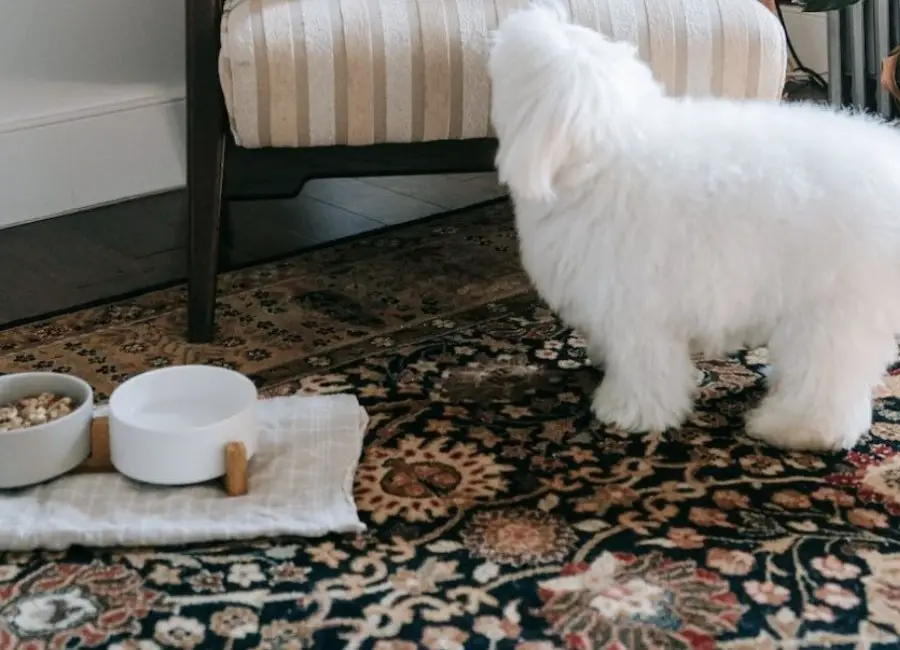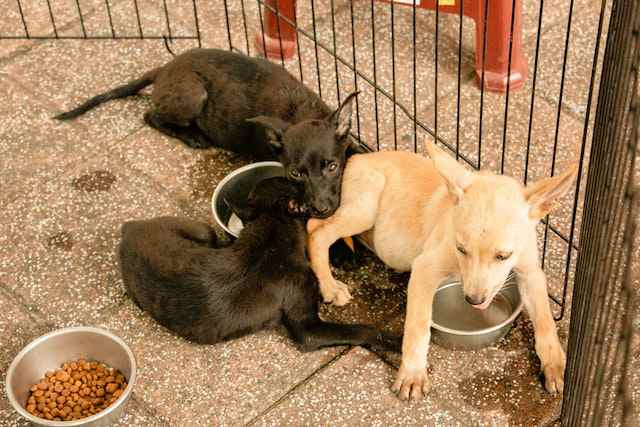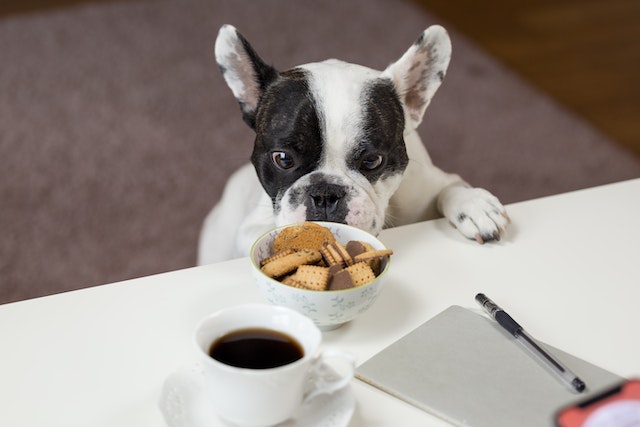10 Reasons for Dog Guarding Food But Not Eating

Let’s discuss reasons for your dog guarding food but not eating…
Have you ever dealt with a situation where your furry friend stands guard over their food, but refuses to eat it?
It can be a frustrating and confusing experience, leaving you wondering why your beloved pup is so protective over their dinner.
In this blog post, we’ll explore the reasons why your dog may be guarding their food and not eating, as well as tips on how to handle this behavior.
So, grab a cup of coffee, and let’s dive in!
Why is My Dog Guarding Food But Not Eating
If your dog is guarding his food but not actually eating it, there can be a few reasons why. One of the most common reasons is anxiety, which can spike when a dog is guarding his food.
Another reason could be fear-based behavior, which is a way for the dog to ensure that others don’t take their food away.
It could also be due to resource guarding, which is a behavior that is defensive of any object they consider to be of high value, not just their food.
It’s best to observe your dog’s behavior closely and consult with a veterinarian or a professional dog trainer to determine the underlying cause and appropriate course of action.
Learn more about dogs hiding under the bed and not eating.
Reasons for Dog Guarding Food But Not Eating

The following are some common reasons for a dog guarding food but not eating:
1. Resource-guarding instinct
Resource guarding is a common instinctive behavior in dogs where they protect their valued possessions, such as food, toys, or territory, from potential threats.
Dogs that guard their food may growl, snap, or even bite when approached. One potential reason for the behavior of guarding food but not eating is that the dog may feel threatened or insecure in their environment.
To fix this issue, it is important to provide a safe and secure environment for the dog and to work on building trust with the dog through positive reinforcement training.
Teaching the dog to associate the presence of people with positive experiences, such as treats and attention, can help reduce their fear or anxiety and ultimately reduce their guarding behavior.
It is also important to avoid intimidating or punishing the dog, as this can make their behavior worse. Seeking help from a professional trainer or behaviorist may also be beneficial in addressing the issue.
2. Abusive or traumatic past
Abusive or traumatic past experiences can be one of the reasons why a dog may guard its food but not eat it.
Dogs who have a history of neglect, starvation, or abuse may develop habits of food guarding as a coping mechanism that helps them survive in a harsh environment. These habits can persist even if the dog is no longer in that environment.
To address this issue, it’s important to work with a professional dog trainer or behaviorist who specializes in dealing with such cases.
They can help you create a customized training program that involves teaching the dog to trust people around their food.
This program should involve gradually increasing the level of trust the dog has in people, starting with feeding in a quiet and less distracting area, and gradually adding distractions until the dog is comfortable and confident eating around people.
Additionally, avoiding any confrontational or punitive approaches is important to prevent triggering the dog’s fears or anxiety.
Reward-based training such as providing treats and positive reinforcement for good behavior can be helpful in building trust and encouraging the dog to feel comfortable around people during feeding time.
With time, patience, and consistent training, dogs with a history of abuse or trauma can learn to overcome their food guarding habits and enjoy their meals in peace.
3. Dental issues
Dental issues in dogs can be one of the potential reasons for dog guarding food but not eating.
Dogs with dental problems such as tooth decay, gum disease, or broken teeth may find it painful or uncomfortable to eat dry or hard food, causing them to be more protective of their softer or easier-to-eat food.
To fix this issue, it is recommended to take the dog to a veterinarian for a dental exam and possible dental treatment.
The veterinarian may recommend a change in the dog’s diet to softer food or recommend dental chews/ toys to help with the dental hygiene of the dog.
Regular dental check-ups and taking care of their oral hygiene can keep dental problems and the issues related to them at bay.
4. Stomach upset
Stomach upset can be one of the reasons why a dog may guard food but not eat.
This could be due to an underlying digestive issue or discomfort caused by overeating or consuming something that upset their stomach.
To fix this issue, it is important to determine the underlying cause of the stomach upset. This could involve a visit to the veterinarian for a proper diagnosis.
Once the cause is identified, changes to the dog’s diet or feeding routine may be necessary, such as smaller and more frequent meals or a switch to a specialized diet.
It is also important to ensure that the dog is not stressed or anxious, as this can inhibit their natural appetite. Providing a calm and quiet feeding environment and reducing any sources of stress can also help improve the dog’s appetite.
Learn more about dog stomach gurgling and not eating.
5. Lack of trust
Lack of trust in dogs can be one of the reasons why a dog may guard its food but not eat. This could be because the dog is afraid that its food may be taken away or it may have had a negative experience in the past where someone took its food away.
Fixing this issue requires patience and time. One way to address this behavior is to gradually teach the dog to trust you by offering food and treats in a calm and controlled manner.
Start by offering small amounts of food to the dog in a quiet room where it feels safe and secure. Gradually increase the amount of food over time as the dog becomes more comfortable with your presence.
You can also train the dog to associate your presence with positive experiences by offering the dog treats and praise when it allows you to approach its food bowl. This can help establish a positive association in the dog’s mind and reduce its guarding behavior.
Learn more about why your dog is acting weird.
6. Fear and anxiety
Fear and anxiety in dogs can lead to guarding behavior, particularly when it comes to food. For some dogs, food represents a scarce resource that they may feel the need to protect.
Additionally, if a dog has a history of being deprived of food, they may be more likely to guard it.
To address this issue, it’s important to create a positive association with food. Start by feeding small meals throughout the day, rather than one large meal.
This will help the dog get used to the idea that food is always available. You can also try hand-feeding and offering treats during mealtime to build trust and create positive associations.
Another technique is to desensitize the dog to people approaching their food bowl. Start by approaching the dog while they’re eating, but only getting close enough to drop a treat into the bowl.
Gradually get closer over time, while continuing to drop treats. Eventually, the dog should come to see people approaching as a positive thing, rather than a threat.
7. Changes in environment or feeding routine
Changes in environment or feeding routine can trigger resource guarding behavior in dogs.
For example, moving to a new house, sharing a living space with other dogs, or altering the feeding schedule can be stressful for dogs and cause them to guard their food.
To address this issue, it’s important to gradually introduce changes and provide positive reinforcement for good behavior.
For instance, start by making small changes in the environment or feeding routine and gradually increase the level of difficulty.
Always supervise feeding sessions and teach the dog to associate positive experiences with people approaching their food bowl.
Additionally, consult with a veterinarian or a professional dog trainer to set up an appropriate behavior modification plan for the dog.
8. Bored with current food
Boredom with current food in dogs can be one of the potential reasons for dog guarding food but not eating.
Dogs, like humans, can get tired of eating the same food every day, and this can result in a lack of interest in food, leading to guarding behavior.
To fix this issue, dog owners can consider changing the dog’s diet to a different flavor or type of food.
It is essential to transition gradually by mixing the new food with the old food over several days to avoid upsetting the dog’s digestive system.
Providing variety in the dog’s meal routine can also help to stimulate their interest in food.
This could involve rotating different protein sources or adding toppings or treats to their meals occasionally.
9. Lack of proper training
Lack of proper training in dogs is one of the potential reasons for dog guarding food but not eating.
This means that the dog may not have been trained properly on how to behave during meal times, and as a result, they may become territorial over their food, even if they are not hungry.
To fix such an issue, it is important for dog owners to train their dogs not only on how to eat properly, but also on how to behave around food.
One effective way to do this is to train the dog to sit and wait before they are allowed to eat. By doing so, the dog is taught to understand that the food is not their property, and they have to wait for permission before eating.
Another useful training method is to practice food exchange exercises. This involves giving the dog a high-value food item, such as a piece of meat, and then swapping it with a lower value food item, such as a piece of kibble.
This teaches the dog that it is okay to give up their food, and that it will be replaced with something else.
10. Food aggression
Food aggression in dogs occurs when they become possessive of their food or treats and are unwilling to share with other animals or people. This can cause them to guard their food and refuse to eat.
Dogs may show signs of aggression such as growling, baring their teeth, or even biting if someone approaches them while they are eating. To address and fix food aggression in dogs, it is important to train them to feel more comfortable around people or other pets during mealtime.
This issue is critical to address as it can be dangerous. An effective approach is to use positive reinforcement techniques, which involve rewarding the dog when people come near their food by giving them highly preferred treats or engaging them with their favorite toys.
For instance, gradually getting closer to the dog while they eat and placing a special treat in front of them or adding tasty food to their bowl can help them associate people approaching their food with positive experiences rather than feeling threatened.
It’s important to note that resolving food aggression in dogs takes time, patience, and consistent training. If you’re struggling to resolve the issue on your own, seeking guidance from a professional dog trainer or behaviorist is recommended.
Learn more about dog possessive toys with other dogs.
How to address dog guarding food but not eating

Here are some tips for addressing food guarding behavior in dogs that don’t eat:
- Identify the root cause of the food guarding behavior – it is essential to understand why your dog behaves this way so that you can address the underlying cause.
- Keep children away – children can inadvertently trigger food guarding behavior in dogs, so keep them away from feeding times or instances where food is involved.
- Avoid punishing the dog – punishment can often exacerbate the problem and make the dog more aggressive.
- Practice positive reinforcement training – using treats and positive reinforcement can encourage good behavior and help build a stronger bond between you and your dog.
- Don’t take away your dog’s food – taking away food can trigger feelings of insecurity and intensify the food guarding behavior.
- Gradually desensitize your dog – By gradually exposing your dog to people and other animals around food, you can help them learn that it is safe to share food or toys.
- Ensure sufficient exercise and stimulation – providing regular exercise and stimulation can help your dog burn off energy and reduce stress, which in turn helps to reduce food guarding behavior.
- Feed separately – if you have multiple dogs, it may be best to feed them in separate areas to reduce competition for food.
- Seek professional help – in more severe cases, it may be necessary to seek the help of a professional dog trainer or behaviorist. They can assess your dog’s behavior and help develop training programs to address the issue.
These tips are not exhaustive, and the most effective approach may vary depending on the specific dog and the situation.
Therefore, it is recommended to consult a professional if the problem persists.
Related Questions
How can I train my dog to stop guarding his food?
You can start by teaching your dog basic obedience commands like “sit” and “stay”, and then practicing these commands during mealtime. Reward your dog for obeying, and gradually work towards being able to approach and touch his food bowl without any guarding behavior.
Is food guarding a common issue in dogs?
Yes, many dogs exhibit some degree of food-guarding behavior. However, it’s important to address the behavior early on to prevent it from escalating.
What are some signs that my dog is guarding his food?
Some signs include growling, snarling, biting, stiff body language, or hovering over his food bowl. These behaviors can be subtle, so it’s important to pay attention to your dog’s body language during mealtime.
Can food guarding be a sign of a larger behavior issue?
Yes, food guarding can sometimes be a sign of anxiety, fear, or other behavioral issues. It’s important to work with a professional trainer or behaviorist if you’re experiencing any behavior problems with your dog.
Is it safe to take away my dog’s food while he’s eating to prevent guarding behavior?
No, never attempt to take away your dog’s food while he’s eating as this could result in a dangerous situation. Only approach your dog’s food bowl when he’s calm and not exhibiting any guarding behavior as part of the training process.
Conclusion
In conclusion, we hope this post has been helpful in shedding some light on why your furry friend might be guarding their food instead of chowing down.
Remember, dogs have their own unique personalities and instincts, and understanding them is the key to building a stronger bond with your pet.
As always, be patient and loving with your pup, and seek the help of a professional trainer if the behavior persists.
